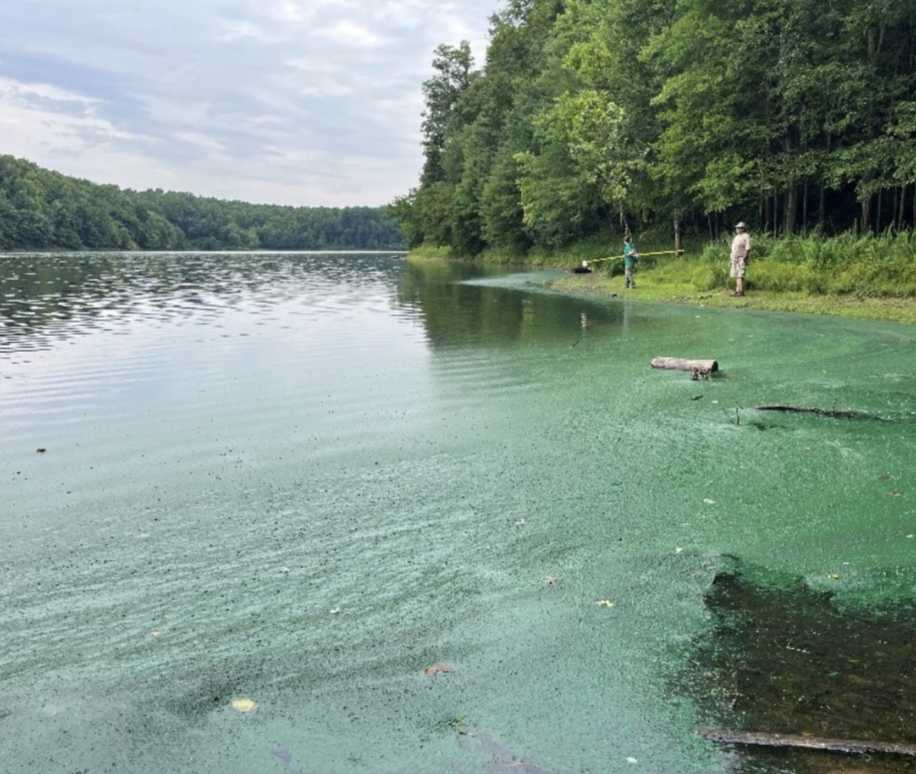Scientists from the Maryland Department of Natural Resources warn the public that freshwater algae mats can occasionally pose a health risk to dogs and other animals. As recently as last summer, Montgomery Parks advised visitors to exercise caution when enjoying recreation on or close to Lake Needwood and Lake Frank, which are located inside Rock Creek Regional Park, because of the possible hazards linked to elevated levels of blue-green algae (cyanobacteria).
Benthic algal mats, according to the Maryland Department of Natural Resources, are collections of algae that might differ in form and appearance but are frequently fibrous, thick, and green. Both flowing and standing water, such as rivers, streams, reservoirs, lakes, and ponds, are home to benthic cyanobacteria mats, which stick to submerged rocks, vegetation, sand, shells, wood, and banks. Additionally, mats may separate and float on the water’s surface, gather in eddies, or wash up on land.
While not all benthic algal mats are harmful, throughout the last two years, poisonous mats have been discovered in Maryland waters. Scientists advise dog owners to keep their pets out of the water while potentially hazardous mats are present because toxins found in these mats can be toxic when consumed. Green, yellow, brown, or black mats are all possible. Lab examination is necessary because a mat’s toxicity cannot be inferred from its appearance alone.
Strong neurotoxins like saxitoxin and anatoxin-a can be produced by certain benthic algal mats (those that contain cyanobacteria). Dogs, cattle, bats, flamingos, waterfowl, and carp have all been recorded to have died as a result of anatoxin exposure. There have been anatoxin-a-related dog fatalities in more than 20 states. Additionally, certain algae mats have the ability to create microcystin, a liver toxin that has killed dogs in Maryland. Dogs are particularly vulnerable and can be exposed by eating algal mats, drinking from natural waterbodies, and washing their paws and fur after swimming.
When a person or pet comes into direct touch with a mat by skin contact or ingestion, they are typically exposed to cyanotoxins. The risk is minimal because adults are unlikely to consume algal mats. However, there is a greater chance that children and dogs will come into touch with mat material. Because of the musty odor, dogs and other animals may actively seek for and consume mats.
Neurotoxins can damage the nervous system if consumed. Anatoxin produces neurological symptoms such as twitching of the muscles, tingling, numbness, salivation, and loss of balance at low to moderate exposure levels. Anatoxin can quickly cause death by paralyzing the respiratory system at high dosages. In the United States, there are currently no national thresholds for either of these pollutants in recreational waterways.
Keep Your Pets Safe
Although blue-green algae concentrations fluctuate throughout the year, the blooms are most prevalent in the middle to late summer when temperatures are at their highest. To keep their pets safe, pet owners should:
- Bring plenty of water for pets to drink. Do not let your pet drink from natural waterbodies.
- Avoid areas where the water appears green, scummy, or has unavoidable benthic mats present.
- Keep pets on leash while hiking near freshwater bodies to avoid consumption of algae.
- Rinse themselves and pets with tap water right after going in the water.
When a dog trembles or has trouble breathing, they should be rushed right away to a veterinarian or emergency animal hospital in their area.
Benthic mats that produce neurotoxins have been found in 15 lakes in Maryland, the Potomac River, and the upper Chesapeake Bay (particularly the Susquehanna Flats and the North East River) in recent years. The first pet health caution alert on the 17-mile non-tidal Potomac River was issued by DNR in 2023 due to a toxin discovery. About 54 miles of the river were the subject of another pet health advisory in 2024.
It is impossible to identify toxic algae by appearance alone. To assist with identifying any hazards, the DNR website offers pictures of benthic mats at the conclusion of this article. People and their pets are reminded by DNR to keep pets outside whenever possible.
Keeping an eye on algae mats
Biologists from the DNR Resource Assessment Service regularly check for algae in 12 state-owned lakes, the Atlantic coast of Maryland, and the Chesapeake Bay. Anatoxins are tested for in the Maryland Department of the Environment laboratory, and saxitoxins are tested for in an outside facility.
In addition to benthic algae mats, DNR and other state agencies keep an eye out for dangerous algal blooms in the water. In addition to producing poisons, these blooms have the ability to tint the water green or reddish brown. There isn’t yet a benthic algae Harmful Algal Bloom (HAB) surveillance program underway in Maryland. Instead, the state’s program is response-based and is initiated by public complaints of suspected benthic HABs and/or field observations by state agency personnel. Responses to suspected benthic HAB outbreaks are coordinated by the Maryland Department of Natural Resources, Maryland Department of the Environment, and Maryland Department of Health.
Research on toxin generation and exposure risk from benthic mats that produce toxins is still being conducted in Maryland and the United States. Recreational users are more likely to encounter mats and possible poisons when benthic cyanobacteria are highly prevalent. If someone thinks they might be exhibiting exposure symptoms, they should call the Maryland Poison Control Center at 1-800-222-222.
Benthic algae mats are currently being investigated and might be more common in the region than previously thought, according to Cathy Wazniak, environmental program manager for DNR’s algae monitoring division. The Patapsco and Patuxent rivers have been found to have cyanotoxins, according to recent data gathered as part of a benthic mat project by the Environmental Protection Agency.
Residents are asked to report any possible algal blooms by DNR and MDE. People can report freshwater blooms nationally by calling Maryland’s Fish Health Hotline #866-633-4686, reporting online at DNR’sEyes on the Bay website, or using the free BloomWatch mobile app.
In addition to reducing nutrient pollution to help prevent dangerous algal blooms, people and dogs should avoid benthic mats when they are present.











